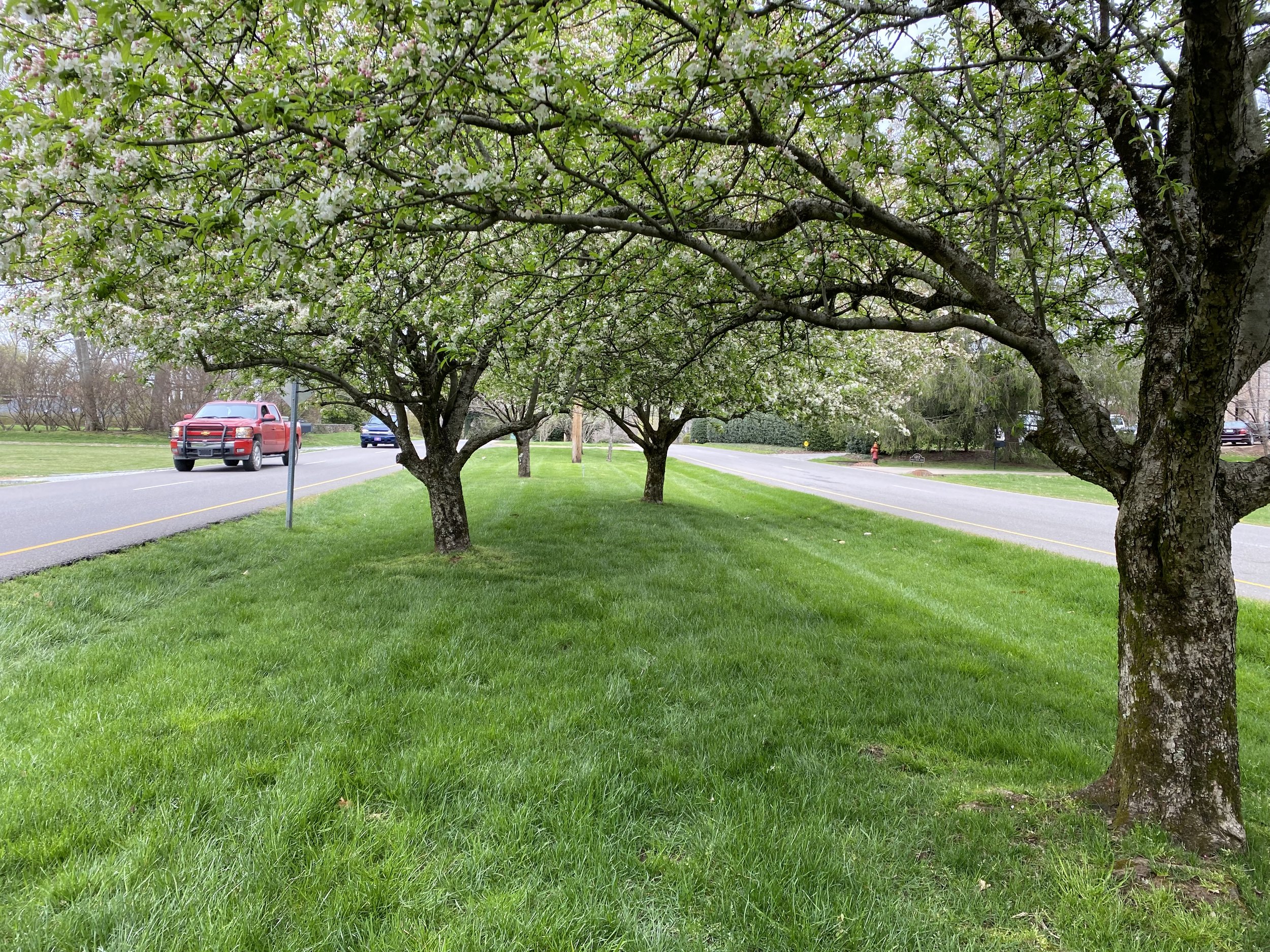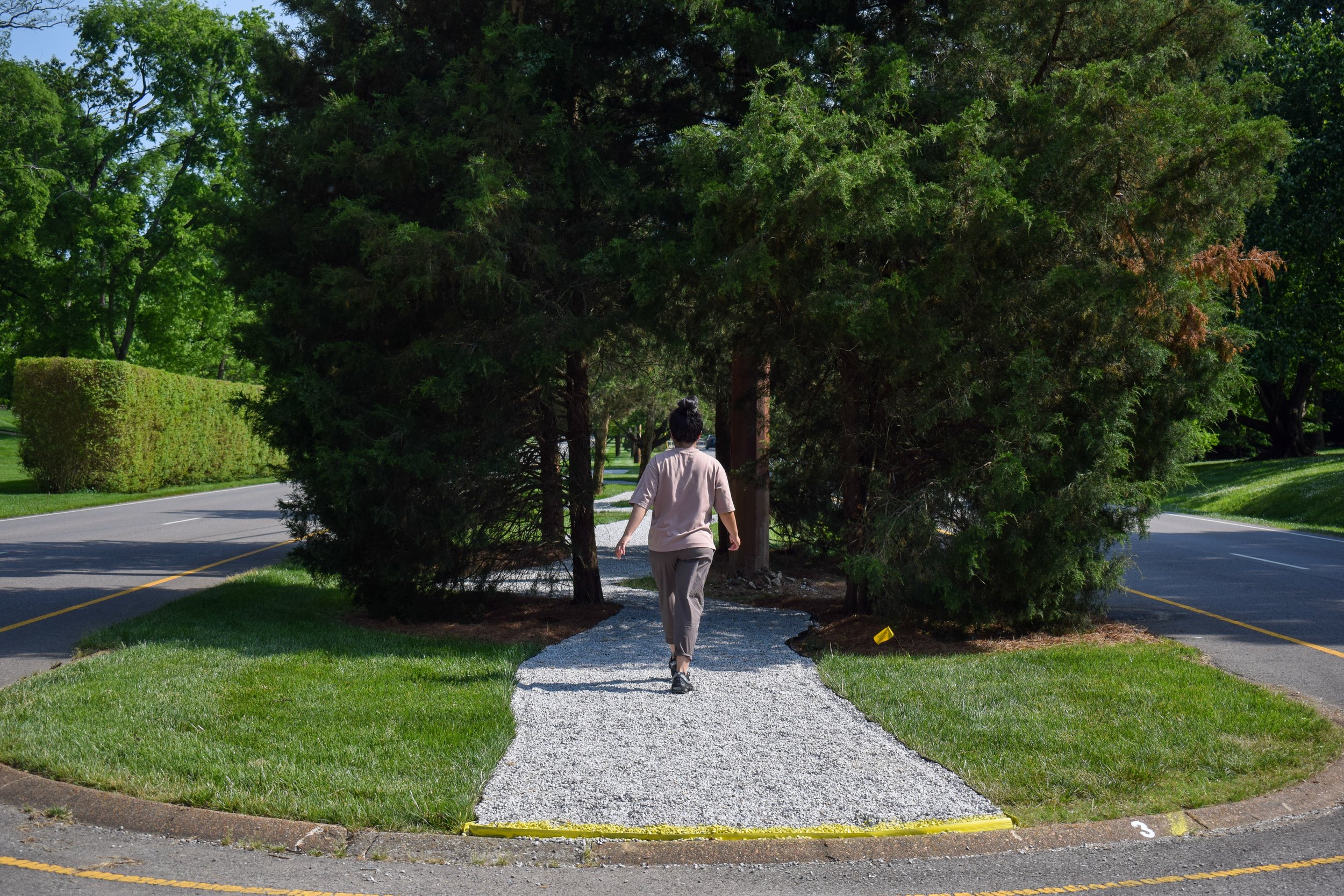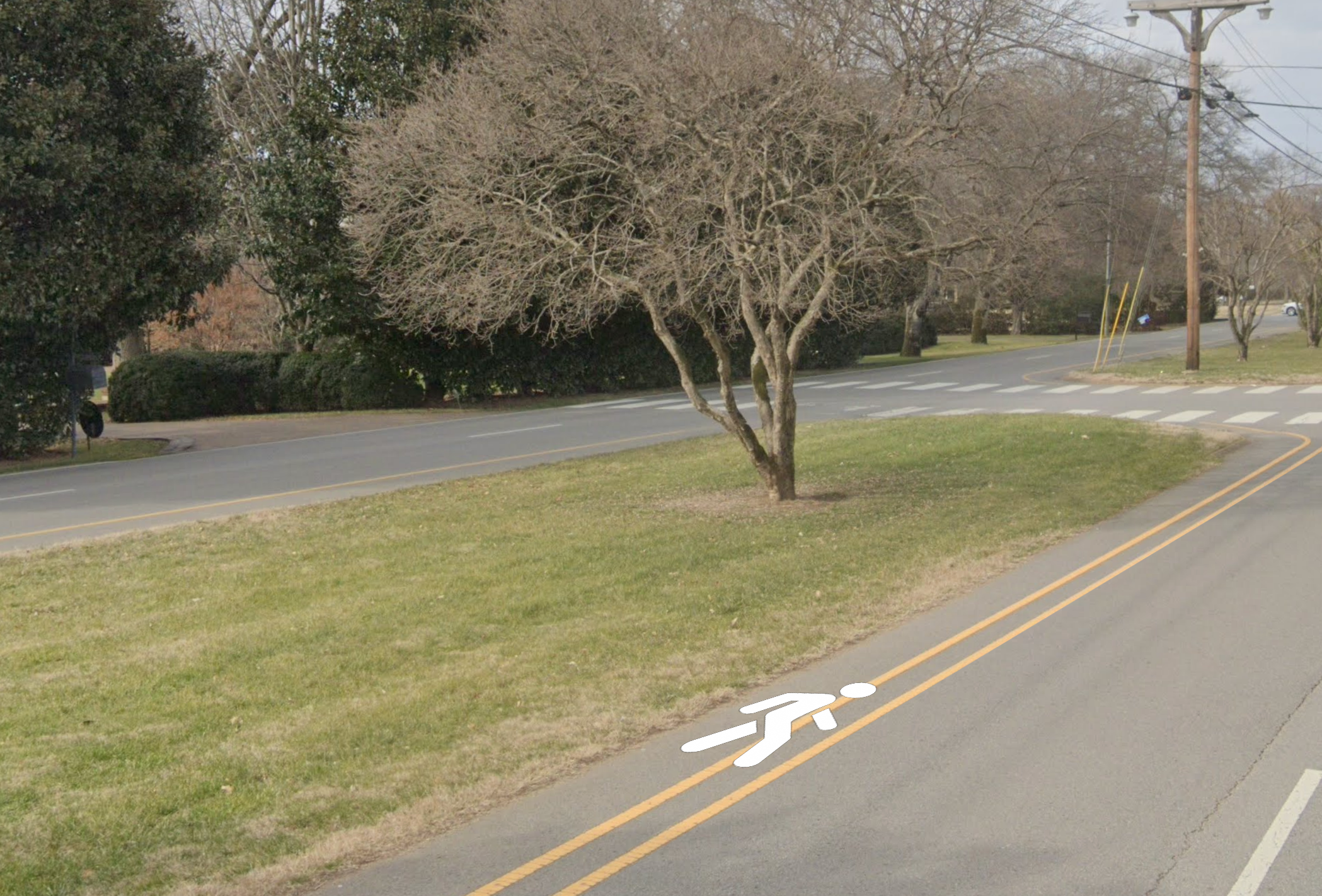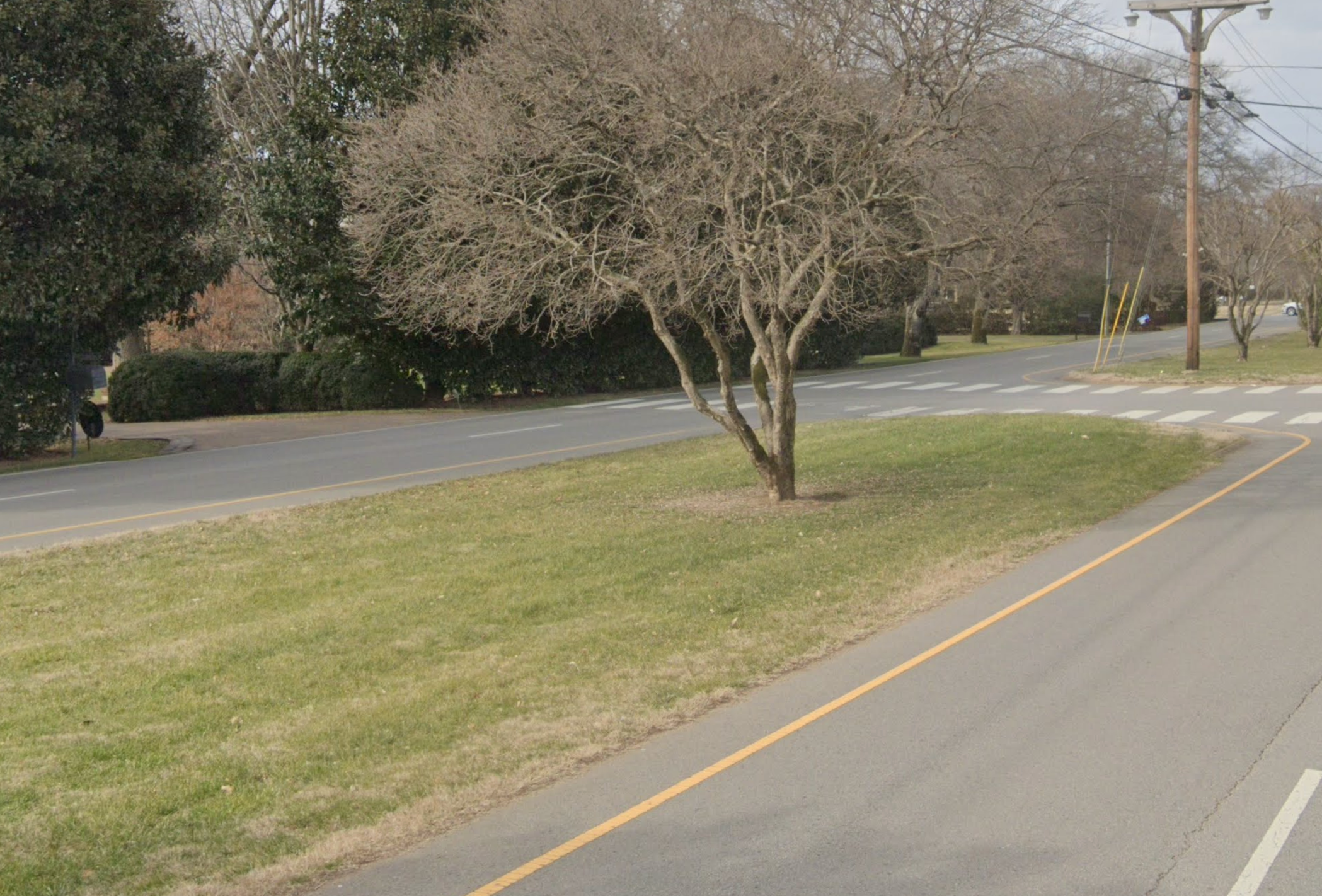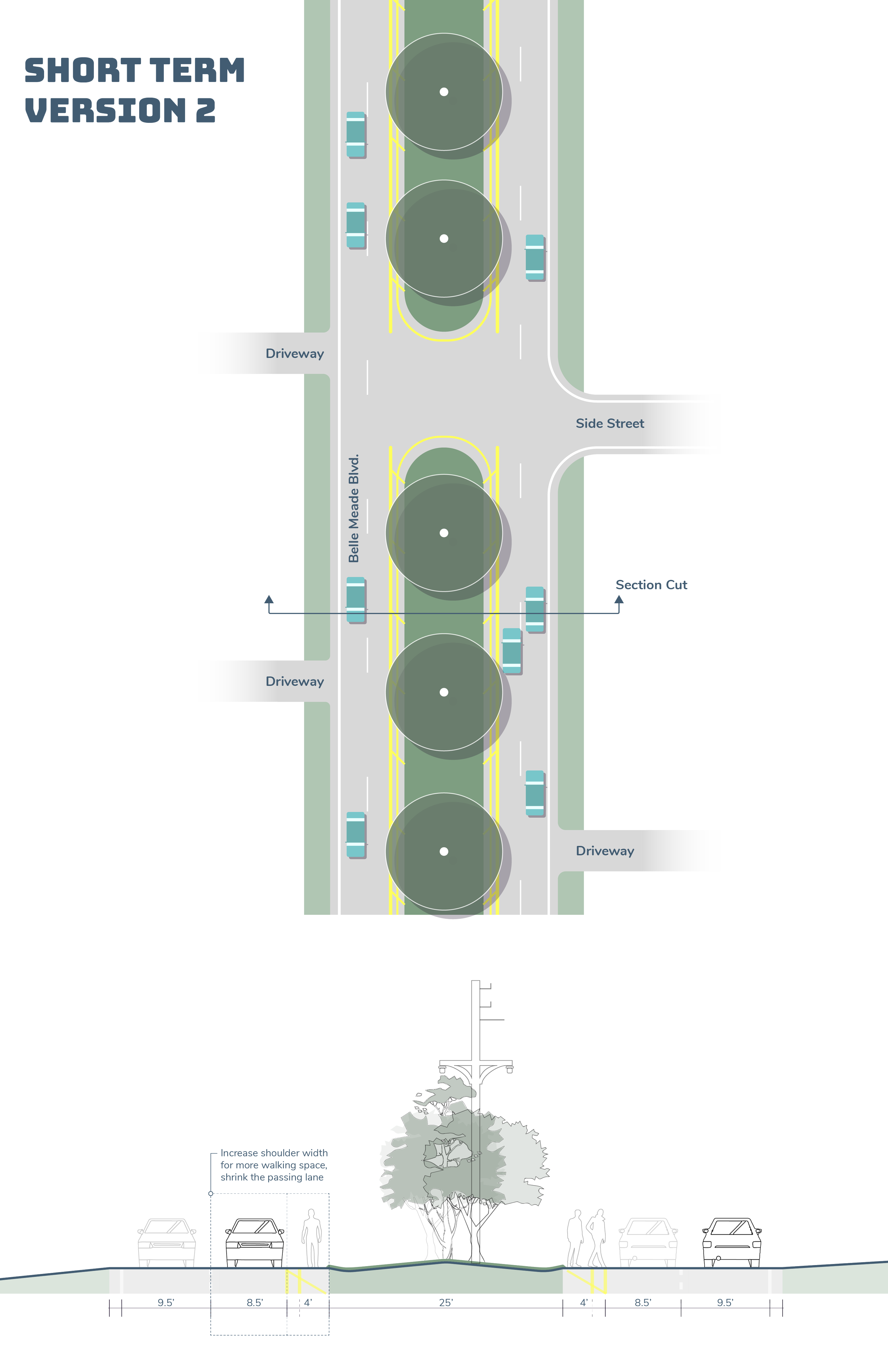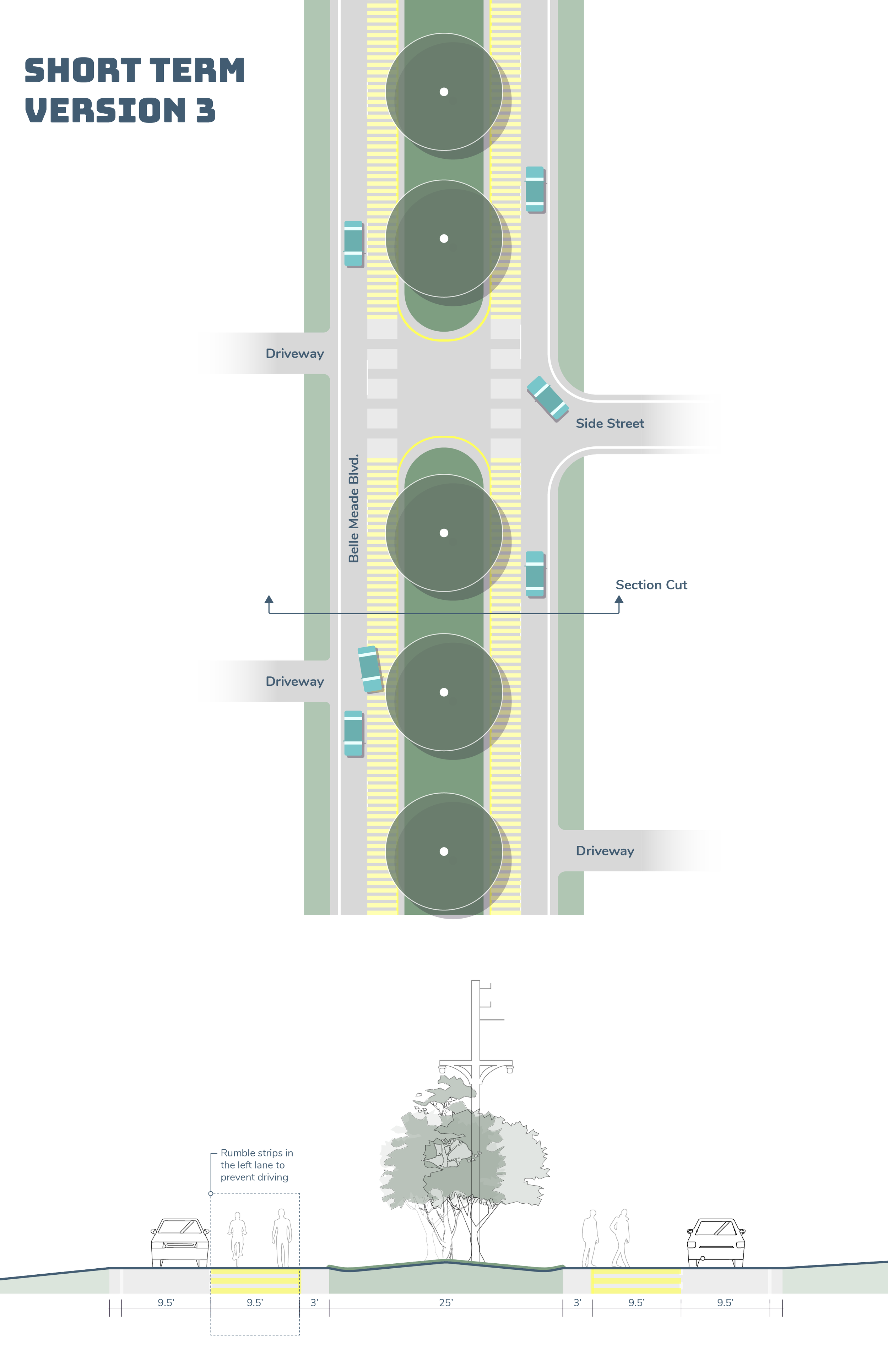Final Report for Demonstration Median Pathway in Belle Meade
By Gretchen Trast, Community Engagement Coordinator
12 min read - Civic Design Center partnered with the City of Belle Meade to install a Tactical Urbanism project. The purpose was to engage the community and explore ways to increase safety on Belle Meade Boulevard. 99% of respondents to community engagement live in the neighborhood.
Civic Design Center Staff engage with Belle Meade Community Members on their thoughts about pedestrian safety on Belle Meade Boulevard.
Exploring Safety on Belle Meade Boulevard
The Civic Design Center partnered with the City of Belle Meade to create a temporary pathway in the median of Belle Meade Boulevard. The tactical urbanism pathway was intended to generate conversation about safety on the boulevard, and explore how the road can function better for all its users.
BackroundThe City of Belle Meade completed the Belle Meade Together Master Plan in October 2021, which focused on 5 major elements: Safe Spaces for People, Security Camera Program, Traffic Calming and Management, Representing Belle Meade’s Brand, and Managing Stormwater. The purpose of this plan was to mitigate consequences of Belle Meade becoming a “cut-through community” via Belle Meade Boulevard in wake of Nashville’s growth and preserve both the street and community’s traditional character.
As a major focus of the plan, new streetscape designs for Belle Meade Boulevard were developed to enhance safety. These can be seen in Figure 1 which are pulled directly from the Belle Meade Together Master Plan. The Civic Design Center’s TURBO Program was contracted by the City to garner feedback on one of the designs, specifically regarding the “Transitions with Belle Median Trail Concept,” in April 2022 (Kimley Horn, 2021, p. 25).
Figure 1: Belle Meade Boulevard Concepts. Conceptual in nature and for continued discussion purposes. (Kimley Horn, 2021, p. 25)
The current streetscape only allows for a small space on the inside left lane for people to walk or bike single file. This makes it increasingly unsafe for two people to walk side by side or to travel with a stroller or pets. Additionally, an indirect effect of prioritizing pedestrian safety is to increase vehicle safety by requiring more drivers to use the road as designed whereas the left lane is only to be used for passing utility or service vehicles that frequently stop. This is due to City ordinance 2013-6. This ordinance:
Restricts driving in the left lane
Restricts a truck/ service vehicle speed to 20mph
For more information on these usage requirements, see Belle Meade ordinance 2013-6.
Tactical Urbanism DesignTactical Urbanism is an approach to neighborhood building that uses short-term, low-cost, and scalable interventions and policies to catalyze long-term change. This approach is relatively new in the South-East, where traditionally any changes to the built environment and public spaces are intended to be long-term. This newer form of community engagement and planning is used by communities throughout the country to test out various designs before committing to a long-term solution. For this project, tactical urbanism was key in getting residents involved in the process as the City of Belle Meade plans for the future of the Boulevard. Although it generated a lot of feedback, it was not clear to the community that the installation was temporary. The median concept was just one way to enhance the boulevard and was intended as an experiment. The City of Belle Meade will make long-term design decisions based on high-quality design and materiality consistent with the City’s Master Plan.
It is important to note that, in some cases, the tactical urbanism approach finds that the existing/ previous conditions of the public spaces were the best suited for the community.
TURBO (a Civic Design Center program), or “Tactical URBanism Organizers”, designed the temporary pathway based on the vision created by Kimley Horn. The main goal of TURBO’s temporary design was to generate a conversation and collect community feedback. The purpose of tactical urbanism is to create temporary, low-cost projects to improve safety while fostering conversation to inform long-term permanent changes. Feedback on the median design was collected via survey that was sent to neighborhoods as well as in-person during a demonstration during the Belle Meade Farmers Market.
Community Survey Results
Feedback on the median design and was collected via survey that was sent to neighbors via email as well as in-person during a community engagement event.
Figure 2. Comparison of total survey respondents to total community population.
The Community Survey for the project accumulated a significant amount of information and insight on how to move forward with improving safety on Belle Meade Boulevard. Over one third of all Belle Meade residents participated in the community survey (n=730). See Figure 2 for a graphic representation of survey respondents compared to the overall community.
Figure 3. Respondent data on those that live in the neighborhood close to the Boulevard.
Further, nearly all respondents indicated that they lived in the neighborhood close to the Boulevard; therefore, making the data sample highly representative of voices that interact with the Boulevard most frequently. See Figure 3 for a graphic representation.
Figure 4. Respondent data on answering the question: “Do you feel safe walking Belle Meade Boulevard on the street or shoulder?”
The survey primarily asked questions about people’s current experience with the Boulevard, their perceptions about safety as a pedestrian or motorist on the Boulevard, and opinions on streetscape design options regarding changes to enhance safety, including the median walkway. The first major finding was that about two thirds of respondents indicated that pedestrian safety could be enhanced on the Boulevard. Figure 4 shows only about one third feeling safe while walking while two thirds felt somewhat safe or not safe at all.
Figure 5. Respondents favorability towards safety enhancements generally and specifically for sidewalks
Another major finding from the survey was that nearly 60 percent of respondents were in favor of safety enhancements, while a smaller majority of participants wanted to see sidewalks installed on Belle Meade Boulevard. This finding is represented in Figure 5.
Compared to all respondents, only 40 percent of respondents who indicated living on the Boulevard (as opposed to in the neighborhood) were in favor or had no preference towards installing sidewalks and only 47 percent were in favor of safety enhancements. This shows that a slight majority of those who live on the Boulevard are not as interested in sidewalks or safety enhancements. However, 84 percent believe that with the right design, pedestrians and motorists can safely share Belle Meade Boulevard.
The last major finding was that people generally felt safer walking on the median; however, respondents were very polarized in their opinion on whether or not the median walkway is the answer to making the street safer for pedestrians.
The following are two comments from respondents in favor of the walkway.
“Walking on the boulevard is so stressful and dangerous! We try to cross it as quickly as possible on our morning and afternoon walks. The plantings are overgrown and difficult to see around when turning. Sidewalks would build community!”
“I live in BM. I walk along BM Blvd nearly every day. I can’t tell you how many close calls I’ve had with cars not minding the left lane prohibition. Excited about the median. Worried it will attract more pedestrian traffic. Willing to take a chance.”
Alternatively, other folks were less pleased with the median walkway, citing changes to the median’s current aesthetic as a major loss and not the right solution.
“The median pathway would not be wide enough. I think expanding the inner shoulder of the BLVD in both ways would be the best option and the most environmentally friendly.”
“Would rather see one lane of traffic given up than ruin the median.”
It is important to point out that in survey responses and in-person conversations, we found that even though the median may not be the right solution, folks who were opposed to the median were oftentimes in favor of other safety enhancing solutions such as taking away part of the roadway from motorists and giving it to pedestrians.
Design Center Recommendations
Overall, after analyzing the community survey data, we found that safer pedestrian infrastructure is a must-have, although the median walkway is likely not a permanent solution. However, this tactical urbanism project fulfilled the foremost goal of sparking valuable conversation to develop a more cohesive vision for Belle Meade Boulevard. The following sections detail short, medium, and long-term visions for safe pedestrian infrastructure on Belle Meade Boulevard. There are three possible short-term visions that feed into medium and ultimately long-term solutions for the Boulevard. Each of these visions are accompanied by a potential design.
Short-term VisionsAll three short-term visions create an intervention within the left lane to deter drivers from staying in the left lane and to only use it as a passing lane. This would in turn increase the amount of room for pedestrians by keeping cars in the right lane while continuing to allow all lanes to be drivable. In addition to these enhancements, we recommend adding signage for clarity of the rules in the short term. This signage can be on the Boulevard, in the parking lots for Metro Parks, and other major intersections throughout the Boulevard.
Short-Term Vision #1: Add Rumble Strips
This vision would install rumble strips along the left lane creating both audible and visual cues to encourage drivers to stay in the right lane.
Short-Term Vision #2: Expand Shoulder Width
This vision would shrink the left lane and physically expand the pedestrian walkway on the left shoulder.
Short-Term Vision #3: Texturize Left Lane
This vision would use paint or thermoplast to texturize the left lane surface, similar to Short Term Vision #1, but would sustain visual cues throughout the entire boulevard.
The following graphics visually represent the Design Center’s recommendations. Changes can be seen in the plan and section views below.
Intervention ComparisonsIntervention Comparison (side by side)Overall, these visual cues on the roadway are proven to be more effective than signage at encouraging drivers to use the roadway as intended, keeping drivers in the right lane.
Additional considerations include educating the public, whether it be at local schools, churches, etc. about the ordinance restricting driving in the left lane. However, this short-term solution can be altered moving forward with either a speed limit reduction or future changes to the Boulevard’s design.
Mid-term VisionThe mid-term vision, an extension of any of the short-term designs, would further deter usage of the left lane while still preserving it. However, this vision would make it even more clear to drivers it is only a passing lane and provide more space for pedestrians. The purpose of the medium term vision is to solidify the streetscaping future (see long-term vision) and to manage traffic. This vision accommodates the existing plan to repave Belle Meade Boulevard, scheduled for 2026, so that once the road is repaved, restriping the road can create a safer environment for pedestrians by…
Narrowing the lanes
Deter driving in the left lane
Delineate pedestrian shoulder from street
It is important to note that all of these recommendations are only recommendations, and that this temporary installation is part of a larger process. The City of Belle Meade and the Commissioners will take these suggestions into consideration when planning their capital spending budget, and there are many other factors that go into improvements to the Boulevard. Inprovement may include stormwater enhancements, paving or restiping, etc.
Long-term VisionOur recommended long term vision of Belle Meade Boulevard is to support growth within the Belle Meade Community by enhancing accessibility to community amenities via Belle Meade Boulevard. The goal of this would be to ensure:
Complete safety for pedestrians
Clear space distinctions for pedestrians and motorists
Preserve or enhance the median
Honor traffic flow
We suggest that the most feasible and effective way to do this is to dedicate the current left lane to pedestrians and use only the right lanes for driving.
Other RecomendationsIn addition to these design recomendations, there are a few other considerations the Design Center recommends in order to enhance the experience and safety of Belle Meade Boulevard. The first is to lower the speed limit to 25 MPH for all vehicular traffic. Currently, the left-hand lane should only be used to pass slow-moving service vehicles (due to ordinance 2013-6). Reducing the speed limit removes the need for service vehicles to be passed by standard traffic, creates a safer street for pedestrians, and takes away the need for a second lane. Recently, Metro Nashville reduced its neighborhood speed limits to 25MPH to increase pedestrian safety. This could be applied to not only Belle Meade Boulevard, but also other neighborhood streets including Trimble, Iroquis, Leake, etc.
Signs from Belle Meade Together Master Plan Final Report by Kimley-Horn
Also, enhanced signage could help with both the current confusion about when cars can use the left lane, as well as keep a consistent brand throughout the City of Belle Meade. Signage is helpful when new traffic patterns arise, and can help transition to a new design.
Civic Design Center Recommendation. for enhanced signage
Moving Forward
The next steps are for the City’s leadership to evaluate the results of community engagement with the annual budget review. This process will determine how to move forward in the coming years.
Let us know what you think about our recommendations in the form below!












